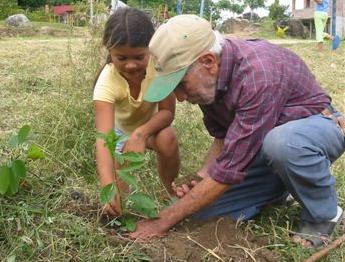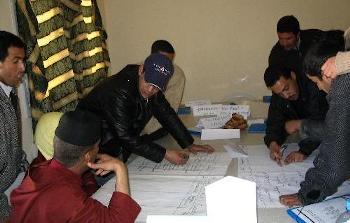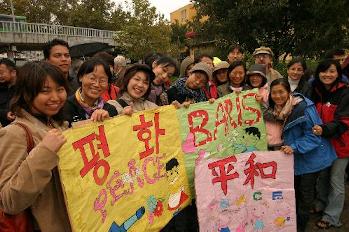|
(continued from front page)

Photo from Concern Universal - Colombia
 This General Assembly definition of the culture of peace is positive rather than negative, going far beyond the previous definition of peace as the absence of armed conflict. This is not always easy for people to understand. For example, “in Japan people are apt to think that peace means the situation without wars and nuclear weapons through the experience the World War. Peace Education means the teaching of the nuclear weapons in Hiroshima and Nagasaki, air raid attack and the battles in Okinawa… We spent a lot of time to make understood the difference between peace and culture of peace to fellow groups or people who made efforts for peace.” Many other organizations also underline that it is important to explain the nature of the culture of peace. This General Assembly definition of the culture of peace is positive rather than negative, going far beyond the previous definition of peace as the absence of armed conflict. This is not always easy for people to understand. For example, “in Japan people are apt to think that peace means the situation without wars and nuclear weapons through the experience the World War. Peace Education means the teaching of the nuclear weapons in Hiroshima and Nagasaki, air raid attack and the battles in Okinawa… We spent a lot of time to make understood the difference between peace and culture of peace to fellow groups or people who made efforts for peace.” Many other organizations also underline that it is important to explain the nature of the culture of peace.
 Although highlights from reports are summarized here, the full information, available on the Internet, is far richer than any summary can indicate. Hundreds of photographs illustrate culture of peace activities, showing a complex picture of children, women, men working, playing, celebrating, demonstrating, Although highlights from reports are summarized here, the full information, available on the Internet, is far richer than any summary can indicate. Hundreds of photographs illustrate culture of peace activities, showing a complex picture of children, women, men working, playing, celebrating, demonstrating,

In Morocco ENDA is strengthening capacities of civil society & local authorities for mutual understanding and dialogue.
|

|
engaging in hundreds of activities that promote life, cooperation, solidarity, hope, commitment to change and improvement of their lives and the lives of others, a view of the culture of peace that cannot be found elsewhere in such a global and all-encompassing vision.
 It is generally agreed that there is a remarkable “scarcity and difficulty of access to resources for the promotion of the culture of peace, in comparison with the immense expenses for the promotion of war and violence.” One exception, perhaps, is the enormous resources devoted to tourism, which, as reported by the International Institute of Peace through Tourism, has a great potential to contribute to a culture of peace. It is generally agreed that there is a remarkable “scarcity and difficulty of access to resources for the promotion of the culture of peace, in comparison with the immense expenses for the promotion of war and violence.” One exception, perhaps, is the enormous resources devoted to tourism, which, as reported by the International Institute of Peace through Tourism, has a great potential to contribute to a culture of peace.
 The qualitative indictors of progress in this report need to be further developed as quantitative indicators for a culture of peace during the second half of the Decade. Starting points are provided by the indicators of international peace and security, human rights and development provided by Escuela de Cultura de Paz, and indicators for peace education referenced by the Peace Studies Program of Clark University. The qualitative indictors of progress in this report need to be further developed as quantitative indicators for a culture of peace during the second half of the Decade. Starting points are provided by the indicators of international peace and security, human rights and development provided by Escuela de Cultura de Paz, and indicators for peace education referenced by the Peace Studies Program of Clark University.

Peace protest by participants from the Peace Boat
 Sharing of information is essential to development of the global movement, as stated by the General Assembly in its resolution A/53/243, especially in view of the failure of the mass media to provide news of the culture of peace. It is generally agreed that systems of information exchange need to be greatly expanded in the second half of the Decade. Important initiatives are already underway, including those described in reports from the Good news Agency, the Transnational Foundation for Peace and Future Research, the Peace Research Information Unit Bonn, the Danish Peace Academy, Education for Peace Globalnet and the International Coalition for the Decade, as well as others in the planning stage such as the Signis Asia Assembly from Malaysia. All of the arts are employed, e.g.: Agencia Internacional para el Fomento de Acciones con Hip-Hop; Conseil International de la Danse; International Forum for Literature and Culture of Peace; Jipa Moyo Comics, The Art Miles Mural Project. Two other Internet sources of culture of peace information have already been supported by General Assembly resolutions: the CP Internet pages of the UNESCO Website and the Culture of Peace news Network. Sharing of information is essential to development of the global movement, as stated by the General Assembly in its resolution A/53/243, especially in view of the failure of the mass media to provide news of the culture of peace. It is generally agreed that systems of information exchange need to be greatly expanded in the second half of the Decade. Important initiatives are already underway, including those described in reports from the Good news Agency, the Transnational Foundation for Peace and Future Research, the Peace Research Information Unit Bonn, the Danish Peace Academy, Education for Peace Globalnet and the International Coalition for the Decade, as well as others in the planning stage such as the Signis Asia Assembly from Malaysia. All of the arts are employed, e.g.: Agencia Internacional para el Fomento de Acciones con Hip-Hop; Conseil International de la Danse; International Forum for Literature and Culture of Peace; Jipa Moyo Comics, The Art Miles Mural Project. Two other Internet sources of culture of peace information have already been supported by General Assembly resolutions: the CP Internet pages of the UNESCO Website and the Culture of Peace news Network.
|
 , PO Box 2305, Branford, CT 06405, USA, Telephone/Fax 1-203-481-2027, Website: http://decade-culture-of-peace.org
, PO Box 2305, Branford, CT 06405, USA, Telephone/Fax 1-203-481-2027, Website: http://decade-culture-of-peace.org